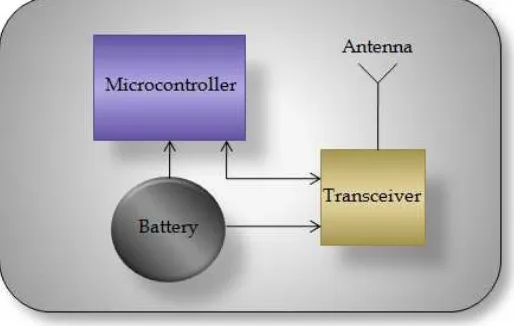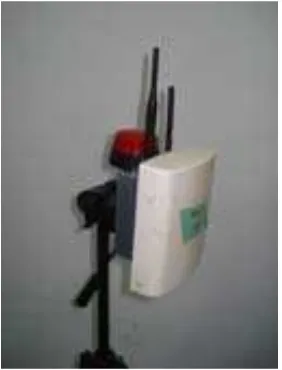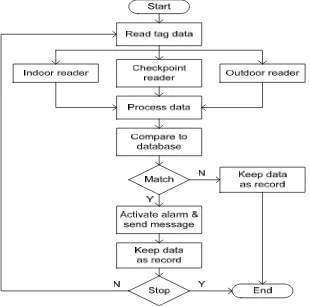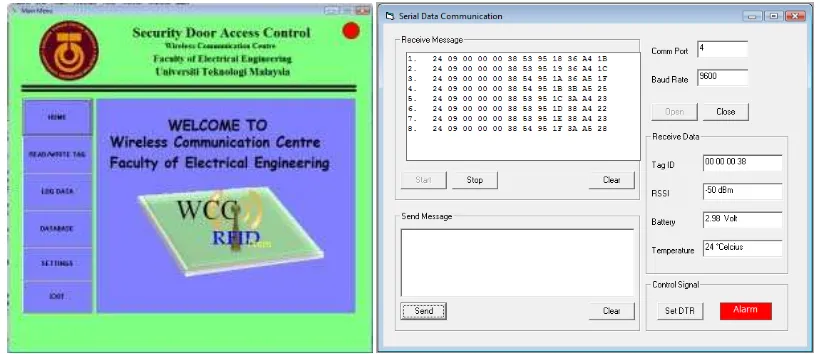Abstrak
Aset merupakan salah satu benda berharga dalam industri atau lembaga, kehilangan aset menjadikan permasalahan pada sistem manajemen aset. Keuntungan dari teknologi identifikasi frekuensi radio (RFID) telah membuat teknologi ini berguna untuk sistem pengelolaan dan pelacakan aset. Penggunaan teknologi RFID aktif untuk pelacakan aset adalah dengan melampirkan tag pada aset atau item dengan diberi ID yang unik untuk identifikasi. Beberapa pembaca RFID aktif diletakan pada titik-titik atau lokasi strategis untuk melacak pergerakan aset dan mengumpulkan informasi ketika setiap item diluluskan di daerah cakupan pembaca. Pembaca mengumpulkan informasi pada jangkauan pembacaan dan mengirim ke sistem backend. Integrasi setiap sistem tunggal dilakukan dengan menggunakan kabel atau metode nirkabel untuk menjaga sentralisasi sistem pengolahan data. Pesan peringatan akan dikirim ke departemen terkait untuk memberikan peringatan. Sistem pelacakan dan manajemen aset yang menggunakan tipe teknologi RFID aktif bekerja pada pita frekuensi ISM 433 MHz. Sistem backend terdiri dari perangkat lunak aplikasi, middleware dan database. Semua informasi yang telah dikirim dari setiap sistem tunggal dicatat dalam satu basisdata pusat.
Kata kunci: RFID, tag aktif, database
Abstract
Asset is one of valuable item in the industry or institution, missing or lose of asset may have problem in asset management system. The advantages of Radio Frequency Identification (RFID) technology have made this technology useful for asset management and tracking system. The use of active RFID technology for asset tracking is by attaching the tag at the asset or item with assigned a unique ID for identification. A few of active RFID readers install at strategic points or location to track asset movement and collect information when anyone of item pass by in reader coverage area, reader collect information with in reading range and send to backend system. Integration every single system by using wires or wireless methods to keep centralize data processing system. Alert message will be send to representative department to give warning. This asset tracking and management system that use active type of RFID technology is working at ISM band frequency of 433 MHz. The backend systems consist of application software, middleware and database. All the information have been sent from every single system recorded in one central database.
Keywords: RFID, active tag, database
1. Introduction
Current EPC gen 2 tags use a 96-bit ID code, which could be expanded if necessary. Market prices of passive tags are currently priced in the cent for large quantities ordered. The chips consist of microcontroller and memory unit in the tags derive their power from the radio field from antenna of the reader. Interrogating the tags to the reader by reflecting and modulating a signal returned to the reader. Tags may have provisions for extended read/write memory. Every tag has a unique ID, the reader may be able to recognize many tags in its field virtually simultaneously, and up to about 1000 tags per second depend on type of reader [2].
Figure 1 shows basic concept of RFID system and how antenna exposes electromagnetic wave and received by tag than tag data transmit back to reader thru antenna. In RFID systems, the tag that stored the information or data can be categories into two different types. Passive tags use the radio frequency from the reader to transmit their signals, passive tags will generally have their data permanently burned into the tag when it is made, although some can be rewritten. Active tags are much more powerful in reading distance because they have on board battery for power to transmit their data signal over a longer distance and be able to stored more data with a random access memory (RAM) in circuit giving them the ability to store up to 128kB of data. Normally for active tag reading range up to 100 meters or more will depend on power of tag and reader, major issue in active RFID system is tag battery lifetime, typically the battery can last up to a few years based on setting of beacon rate [3].
Similar like tuning into your favorite radio station, RFID tags and readers also must be tuned into the same frequency band to enable communications both of equipment. RFID systems can use a variety of frequencies to communicate, because radio waves work and act differently at different frequencies as standardization, basically frequency band of RFID system categories into LF, HF, UHF and Microwave. A frequency for a specific RFID system is often dependant on its application. UHF (Ultra High Frequency) RFID systems 860 MHz to 960 MHz, currently most people uses this band for passive system and 433 MHz or 2.4 GHz for active system [4].
2. Active RFID Technology
An RFID tag is called active tag when it is powered by a battery that can be used as a partial or complete source of power for the tag's circuitry and antenna. Some active tag battery capable for replaceable of several years of use, and some others are sealed unit that difficult to replaceable and prepare for one cycle use. Figure 2 shows basic concept of an active RFID tag that consist component such as transceiver, microcontroller for controlling data transaction, a battery for power supply and antenna as media to convert to electromagnetic wave.
Figure 2. An active RFID tag
Figure 3. Basic concept active RFID system
3. Active RFID for Asset Tracking and Management System
RFID can be used to tract assets in a company or manufacturer. It is a diverse application that can have different meanings to different company or organizations. Some companies or organizations view asset tracking as the physical items means to count the non-sellable assets within offices, factories, or labs. Others organizations definite asset tracking is when items or assets are moving from one facility to others facility, either expecting them to return or move from one balance sheet to another. RFID asset tracking is non-vertical in nature, many different industries such as university, healthcare, manufacturing, insurance, banking, government and even law offices are using RFID technology in a slightly different environment and application [5].
Figure 4. Basic concept active RFID for asset tracking
3.2. Tracking Management System Design
In this design of RFID system for asset tracking, it consists of three major part, indoor tracking system, outdoor tracking system and checkpoint tracking system. Every system has different scenario but all the information will be sent to same backend system. The data from each single system will send information to the server via Ethernet LAN for indoor system, radio link for outdoor system and WiFi and LAN for checkpoint system.
Figure 5 shows the architecture of RFID asset tracking system for every tracking location and how the information sends back to the backend system. RFID middleware and application software are used to verify the information and send back to alarm system.
3.2.1. Indoor Tracking System
Figure 5. Architecture diagram of RFID asset tracking
Figure 6. Active RFID tag
Figure 7 shows the proposed active RFID reader used in indoor tracking system. The reader is powered by Dc 12 V. A battery is attached as a backup power supply. Backup power supply is added to give continuous power to reader.
3.2.2. Outdoor Tracking System
Figure 7. Active RFID reader for indoor system
3.2.3. Checkpoint Tracking System
Checkpoint tracking system use the same concept as explained in precious section, the only different is the antenna part; in this case directional antenna is used. The reader used for checkpoint system is set with maximum transmits power and directional antenna are used, direction of antenna facing to way of vehicle going out checkpoint. With directional antenna reading range of reader can reach up to 100 meters and items or assets in vehicle are still be able to be detected. Reading distance or coverage area of reader can be adjusted depend on requirement, in this application setting distance is 30 meters, with this setting items inside vehicle still can be detected also in various types of vehicle [7].
Figure 8. Active RFID reader for checkpoint system
Figure 9. Data management flowchart
Middleware are used for buffer between readers to application software, with some data filtering to avoid unnecessary data processed. Unnecessary data may slower down the system. Application software communicate to server database to keep update every transaction of data and recorded. Figure 10 shows RFID application software used for this asset tracking system and middleware system as buffer between readers to application system. Application software also shows equipment identity from which reader information captured [7].
4. Results and Analysis
Figure10. Application software and RFID middleware
Figure 11. Graph reader reading distance vs RSSI
Experiment was successful tested by using spectrum analyzer to collect data of receive signal strength from the tag. Equipment setups and setting such as antenna gain, power transmits and distance based on system configuration. Result shows different response for each system, this due to environment factor and propagation effect.
Simple Frii’s Equation :
π
equation (1), where Pr is receive power in dBm, Pt is transmit power of reader in dBm, Gt is reader antenna gain in dBi, Gr tag antenna gain in dBi and R is distance between reader to the tag in meter. In this experiment reader and tag power transmits is fix also for antenna gain and propagation factor, so variable factor is distance between reader to tag. In the testing a few scenarios of distance between tag to reader tested and data collected as shows in graph fig. 11 above.
Measurement result indicate with red color line in the graph is indoor tracking system with 3 dBi antenna gain, reading distance up to 100 meters as shows in the graph with RSSI -130 dBm. Second result is for outdoor systems that indicate in blue color line shows reading distance up to 100 meters with 5 dBi antenna gain, in this case shows RSSI -110 dBm. Lastly for checkpoint systems as indicate in graph green color line shows good response, for the 100 meters reading distance shows RSSI -90 dBm and for 120 meters reading distance from reader shows -100 dBm. All the results used different type of antenna and antenna gain.
Radio signal strength indicator (RSSI) in each system as mention before are used for reference alarm indicator, alarm system to alert to the officer or staff that unauthorized item passing through or away from the home of location. Result of RSSI as shown in fig. 10 is not linier between signal to distance but it is enough for indicator reference. Since this system does not require precision input reference. At the same time when alarm is triggered, on the monitoring display shows the picture of the items captured, all the information keeps in one central database. Centralize database choose because to provide one source and centralize record. By using GSM module that connected to central server, a message will send to representative person use them mobile phone to give alert and information when unauthorized items or asset pass thru checkpoint that belong respective department. This system used to give faster response to the officer.
5. Conclusion
Asset tracking and management system using active RFID technology successfully test and working, the system is separate by three major systems, namely indoor tracking system, outdoor tracking system and checkpoint tracking system. All the information captured by respective tracking system send to one central backend system, application software will process the information receive by refer to item information that keep in the central database. If the item captured is unauthorized to bring out than alarm will alert staff or officer, respected item displayed on screen to know actual item detected, also message are send to respective person to alert to the owner. All the information and transaction recorded in a database for checking and documentation purpose.
Alarm system input trigger by using RSSI signal received, using RSSI system as reference indicator, system can determine distance or radius of detected items, alarm triggered zone for alarm system can be adjust depend on location and environment required. The use of RSSI signal as alarm reference indicator because of parameter have easy to set, also in this system does not required high accuracy in distance measurement, as the main objective this system is to detect asset movement and tracking system.
References



